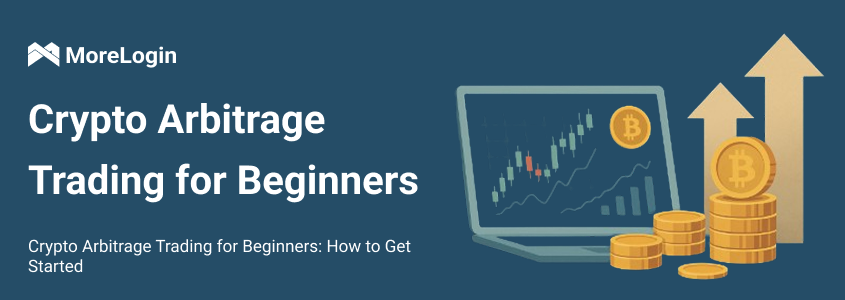
- Product

- Pricing
- Affiliate Program
- Use Cases
- Resource


Cryptocurrency markets are known for their price volatility and global reach. These features make them ideal for a trading strategy known as crypto arbitrage. For those just getting started, crypto arbitrage trading offers a structured and relatively low-risk way to explore the world of digital assets.
Crypto arbitrage trading for beginners is an opportunity to take advantage of price differences across exchanges. It doesn't require advanced trading strategies or complex market analysis, making it one of the more approachable strategies for new traders.
This guide explains what crypto arbitrage trading is, how it works, and what tools and steps beginners should use to get started.
Before jumping into trading, it's important to understand how cryptocurrency markets work.
1. What Are Crypto Exchanges?
Crypto exchanges are platforms where users buy, sell, and trade cryptocurrencies. Some of the largest include Binance, Coinbase, and Kraken. Each exchange operates independently, which leads to variations in prices for the same cryptocurrency across different platforms.
2. Price Differences and Liquidity
Due to differences in liquidity, demand, and user behavior, prices can vary slightly or significantly between exchanges. These price differences are the basis of arbitrage opportunities. A trader might find Bitcoin priced at $30,000 on Exchange A and $30,200 on Exchange B. Buying on A and selling on B can generate a quick profit.
3. Types of Crypto Arbitrage
Spatial Arbitrage: Buying crypto on one exchange and selling it on another.
Triangular Arbitrage: Exploiting price differences between three currencies on the same exchange.
Statistical Arbitrage: Using algorithms to identify patterns and price inefficiencies.
4. Risks to Consider
Crypto arbitrage isn't risk-free. Risks include:
Transfer delays
High transaction fees
Market price changes during execution
Exchange withdrawal limits or KYC delays

To start crypto arbitrage trading for beginners, preparation is key. You’ll need to register on multiple exchanges and set up a toolkit for tracking and trading efficiently.
1. Choose the Right Exchanges
Select 2–3 reliable exchanges with high liquidity and low transaction fees. It’s necessary to register accounts on all of them. This enables fast movement between platforms. Some exchanges to consider include Binance (the largest global exchange with low fees and a wide selection), Coinbase(strong compliance and beginner-friendly UI), Kraken(high security and fiat support), KuCoin(fast listings and diverse tokens), and Bybit(derivatives-focused with a clean interface).
2. Fund Allocation
Start with small amounts. A good rule is to invest no more than 10–15% of your total crypto capital in arbitrage. Keep some funds in reserve to cover fees and emergencies.
3. Tools to Prepare
Price Monitoring Tools: Sites like CoinMarketCap, CoinGecko, and TradingView help track real-time prices across exchanges.
Arbitrage Calculators: Tools such as ArbiTool or Altrady Arbitrage Calculator help assess whether a price difference is enough to yield profit after fees.
Trading Bots: Beginner-friendly bots like Bitsgap or Cryptohopper can automate arbitrage tasks.
Browser Management Tool: Morelogin
Managing multiple exchange accounts can trigger detection algorithms, especially if done from the same browser or IP. Morelogin Arbitrage Creatives explains how to create isolated browser profiles with separate fingerprints. This helps users safely manage multiple exchange accounts, monitor market prices, and perform trades without being flagged by platform security systems. The tool also supports proxy integration, team collaboration, and automation-friendly setups.
Before you begin, ensure you have verified accounts on multiple exchanges, sufficient capital, and a basic understanding of blockchain transfers. Once ready, proceed as follows:
1. Spot a Price Difference
Use price monitoring tools or bots to identify a coin with a notable price gap between two exchanges.
2. Confirm the Opportunity
Use an arbitrage calculator to check if the price difference justifies the fees involved. Include network fees, withdrawal fees, and trading fees.
3. Execute the Buy Order
Buy the cryptocurrency on the lower-priced exchange.
4. Transfer the Asset
Send the crypto to your account on the higher-priced exchange. Make sure the network selected matches the coin’s supported transfer protocol (e.g., ERC-20, BEP-20).
5. Sell the Crypto
Once it arrives, sell it on the second exchange. Confirm the market price hasn't changed significantly.
6. Calculate the Profit
Subtract all fees and compare the final amount to your starting capital. If positive, you’ve completed a successful arbitrage trade.
Once you've completed your first trade, it’s important to focus on improving efficiency, minimizing risk, and developing consistent habits. The tips below are designed to help crypto arbitrage trading for beginners become more structured and successful over time.
Learn to Read the Market
Even though arbitrage is based on price differences, understanding market trends and timing improves your success rate.
Use Automation Tools
Crypto arbitrage trading for beginners becomes more efficient with bots and scripts that can monitor and execute trades faster than humans.
Manage Risks Properly
Set stop-loss limits to prevent loss during fast-moving markets. Always double-check fees before trading.
Start Small and Scale Slowly
Avoid using high leverage or putting all your funds into one trade. Gain confidence through repetition.
Stay Compliant
Ensure your exchanges and tools follow data protection laws like GDPR or CCPA. This helps protect your identity and funds.

Crypto arbitrage trading for beginners is a strategic way to enter the crypto market with limited exposure to complex analysis or market timing. By using tools like price trackers, bots, and Morelogin for account management, new traders can operate efficiently and safely.
Focus on learning the process, minimizing risks, and gradually increasing scale. Start small, track your results, and grow your experience. Arbitrage may not be risk-free, but for beginners, it offers a structured and repeatable entry point into crypto trading.